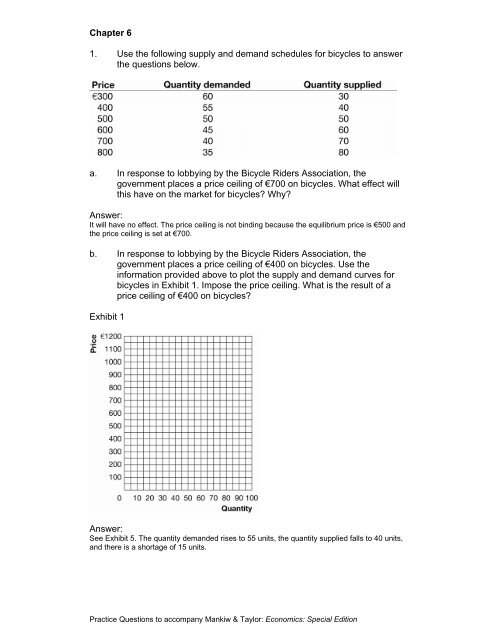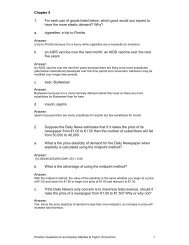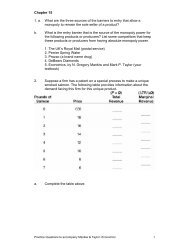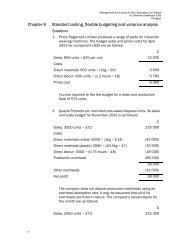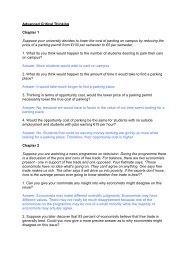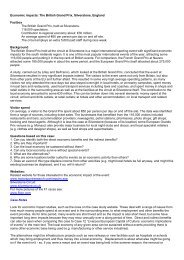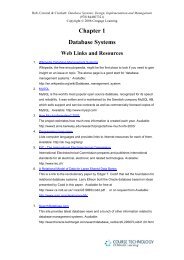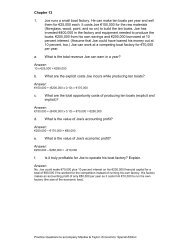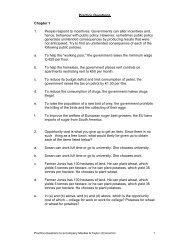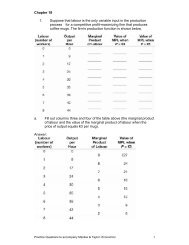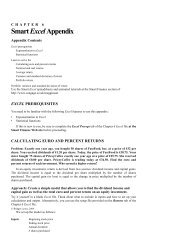Create successful ePaper yourself
Turn your PDF publications into a flip-book with our unique Google optimized e-Paper software.
<strong>Chapter</strong> 61. Use the following supply <strong>and</strong> dem<strong>and</strong> schedules for bicycles to answerthe questions below.a. In response to lobbying by the Bicycle Riders Association, thegovernment places a price ceiling of €700 on bicycles. What effect willthis have on the market for bicycles? Why?Answer:It will have no effect. The price ceiling is not binding because the equilibrium price is €500 <strong>and</strong>the price ceiling is set at €700.b. In response to lobbying by the Bicycle Riders Association, thegovernment places a price ceiling of €400 on bicycles. Use theinformation provided above to plot the supply <strong>and</strong> dem<strong>and</strong> curves forbicycles in Exhibit 1. Impose the price ceiling. What is the result of aprice ceiling of €400 on bicycles?Exhibit 1Answer:See Exhibit 5. The quantity dem<strong>and</strong>ed rises to 55 units, the quantity supplied falls to 40 units,<strong>and</strong> there is a shortage of 15 units.Practice <strong>Questions</strong> to accompany Mankiw & Taylor: Economics: Special Edition
Exhibit 5c. Does a price ceiling of €400 on bicycles make all bicycle buyers betteroff? Why or why not?Answer:No. It may make those bicycle buyers better off that actually get a bicycle. However, somebuyers are unable to get a bike, must wait in line, pay a bribe, or accept a lower qualitybicycle.d. Suppose instead, in response to lobbying by the Bicycle ManufacturesAssociation, the government imposes a price floor on bicycles of €700.Use the information provided above to plot the supply <strong>and</strong> dem<strong>and</strong>curves for bicycles in Exhibit 2. Impose the €700 price floor. What isthe result of the €700 price floor?Exhibit 2Practice <strong>Questions</strong> to accompany Mankiw & Taylor: Economics: Special Edition
Answer:See Exhibit 6. The quantity supplied rises to 70 units, the quantity dem<strong>and</strong>ed falls to 40 units,<strong>and</strong> there is a surplus of 30 units.Exhibit 62. Use the following supply <strong>and</strong> dem<strong>and</strong> schedules for bicycles to answerthe questions below.Practice <strong>Questions</strong> to accompany Mankiw & Taylor: Economics: Special Edition
a. Plot the supply <strong>and</strong> dem<strong>and</strong> curves for bicycles in Exhibit 3. On thegraph, impose a tax of €300 per bicycle to be collected from the sellers.After the tax, what has happened to the price paid by the buyers, theprice received by the sellers, <strong>and</strong> the quantity sold when compared tothe free market equilibrium?Exhibit 3Answer:See Exhibit 7. The price buyers pay rises to €700, the price sellers receive falls to €400, <strong>and</strong>the quantity sold falls to 40 units.Exhibit 7Practice <strong>Questions</strong> to accompany Mankiw & Taylor: Economics: Special Edition
. Again, plot the supply <strong>and</strong> dem<strong>and</strong> curves for bicycles in Exhibit 4. Onthe graph, impose a tax of €300 per bicycle to be collected from thebuyers. After the tax, what has happened to the price paid by thebuyers, the price received by the sellers, <strong>and</strong> the quantity sold whencompared to the free market equilibrium?Exhibit 4Answer:See Exhibit 8. The price buyers pay rises to €700, the price sellers receive falls to €400, <strong>and</strong>the quantity sold falls to 40 units.Exhibit 8Practice <strong>Questions</strong> to accompany Mankiw & Taylor: Economics: Special Edition
c. Compare your <strong>answers</strong> to questions (a) <strong>and</strong> (b) above. Whatconclusion do you draw from this comparison?Answer:The impact of a tax collected from sellers is equivalent to the impact of a tax collected frombuyers.d. Who bears the greater burden of this tax, the buyers or the sellers?Why?Answer:The greater burden of the tax has fallen on the buyers. The free market equilibrium price was€500. After the tax, the price the buyers pay has risen €200 while the price the sellers receivehas fallen €100. This is because dem<strong>and</strong> is less elastic than supply.Practice <strong>Questions</strong> to accompany Mankiw & Taylor: Economics: Special Edition


